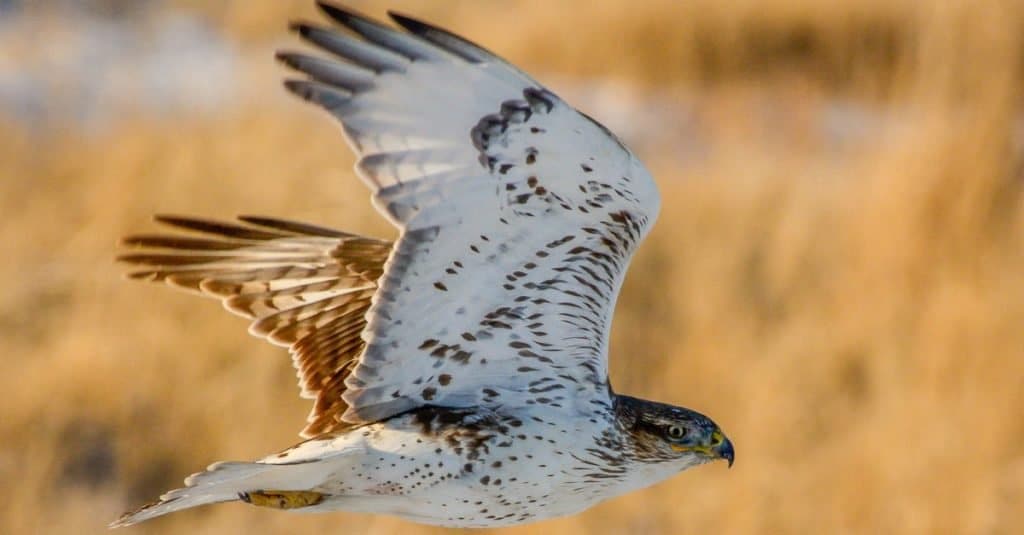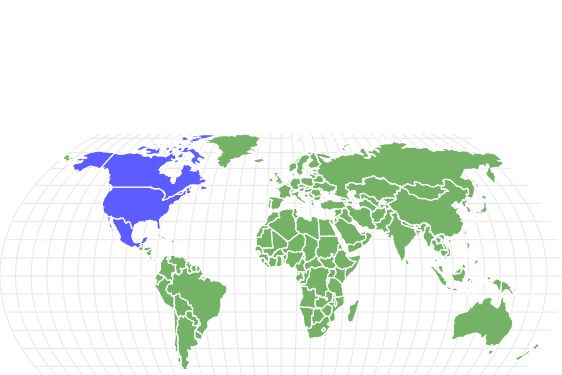Ferruginous Hawk
.jumbotron {
background-image: url(“https://a-z-animals.com/media/2021/06/Ferruginous-Hawk-header-400×300.jpg”);
}
}
@media only screen and (min-width: 641px) and (max-width: 920px) {
.jumbotron {
background-image: url(“https://a-z-animals.com/media/2021/06/Ferruginous-Hawk-header-470×370.jpg”);
}
}
@media only screen and (min-width: 921px) {
.jumbotron {
background-image: url(“https://a-z-animals.com/media/2021/06/Ferruginous-Hawk-header.jpg”);
}
}
Ferruginous Hawk
Buteo regalis
The ferruginous hawk comes in both light and dark morphs
Ferruginous Hawk Scientific Classification
- Kingdom
- Animalia
- Phylum
- Chordata
- Class
- Aves
- Order
- Accipitriformes
- Family
- Accipitridae
- Genus
- Buteo
- Scientific Name
- Buteo regalis
Read our Complete Guide to Classification of Animals.
Ferruginous Hawk Conservation Status
Ferruginous Hawk Facts
- Prey
- Rodents, rabbits, hares, gophers, reptiles, amphibians, small birds, and insects
- Fun Fact
- The ferruginous hawk comes in both light and dark morphs
- Estimated Population Size
- Tens of thousands
- Biggest Threat
- Loss of nesting sites
- Most Distinctive Feature
- Rust-colored plumage
- Other Name(s)
- Ferruginous rough-leg hawk
- Wingspan
- 4-5ft
- Incubation Period
- A month
- Habitat
- Open dry plains
- Predators
- Golden eagles, bobcats, and coyotes
- Diet
- Carnivore
- Type
- Bird
- Common Name
- Ferruginous hawk
- Number Of Species
- 1
- Location
- North America
- Nesting Location
- Cliffs, trees, and other high structures
- Age of Molting
- 5-6 weeks
- Migratory
- 1
This post may contain affiliate links to our partners like Chewy, Amazon, and others. Purchasing through these helps us further the A-Z Animals mission to educate about the world’s species..

Spiders that fly! Fish that walk! And 1000+ more incredible animals. Discover them all for FREE
.photo-gallery {
–margin: 0px auto 0px;
–padding: 0px 0px 0px 0px;
}
.gallery-link {
background-image: url(“https://a-z-animals.com/media/2021/06/Ferruginous-Hawk-close-up-1024×535.jpg”);
background-repeat: no-repeat;
background-size: cover;
background-position: center;
height: 500px;
justify-content: center;
text-align: center;
align-items: center;
display: flex;
border: 2px solid #000;
}
.gallery-link img {
height: 50%;
}
@media only screen and (max-width: 768px) {
.gallery-link {
height: 300px !important;
}
}
View all of the Ferruginous Hawk images!
The ferruginous hawk is among the top predators, soaring majestically with its wings outstretched over the open plains of western North America.
The name of the hawk is derived from the Latin word ferrum for iron. This refers to the rusted iron color of the hawk’s feathers. Their unique color pattern, their large size, and their feathered legs help to identify them.
3 Amazing Ferruginous Hawk Facts!
- By drawing in its wings, the ferruginous hawk can dive down at astonishing speeds of 150 miles per hour. It can surprise a prey before the animal even knows it’s in danger.
- Ferruginous hawks play a beneficial role in the environment by keeping rodent populations in check.
- The ferruginous hawk can be taught by humans to hunt down prey on command. This is a practice known as falconry.
Where to Find the Ferruginous Hawk
The ferruginous hawk can be found in a large, unbroken stretch of territory between southwestern Canada, the western United States, and northern Mexico. It prefers to hunt near open plains such as dry prairies, sagebrush, and deserts, where it can easily get the drop on unsuspecting prey.
button.pulse {
transform: scale(1); animation: pulse 2s infinite;
box-shadow: 0 0 0 0 rgba(11, 247, 25, 1);
}
@keyframes pulse {
0% { transform: scale(0.90); box-shadow: 0 0 0 0 rgba(11, 247, 25, 0.5); }
60% { transform: scale(1); box-shadow: 0 0 0 15px rgba(11, 247, 25, 0); }
100% { transform: scale(0.90); box-shadow: 0 0 0 0 rgba(11, 247, 25, 0); }
}
Ferruginous Hawk Nests
The ferruginous hawk prefers to take up residence in the tall heights of trees, cliffs, dirt piles, and even manmade structures like power poles and windmills. The nest is built out of sticks and other random materials like wires and plastic.
Ferruginous Hawk Scientific Name
The scientific name of the ferruginous hawk is Buteo regalis. This is a Latin term that roughly means royal buzzard or hawk. It is closely related to the red-tailed hawk and the rough-legged hawk, among many other species.
Ferruginous Hawk Size, Appearance, and Behavior
The ferruginous hawk is the largest of all North American hawks. With its large body, big head, and broad wings, it’s sometimes even mistaken for an eagle. This species has a height of about 22 to 27 inches and a weight of up to 4.5 pounds. The female is generally larger than the male, but their plumage pattern is almost completely identical.
This species comes in two different variations: light and dark morphs. The light morph has a pale grey head, a white breast with reddish-brown markings, and rust-colored wings with black fringes. The dark morph, by contrast, has a greater prevalence of dark brown and black colors covering the head and wings. One potential way to identify this species is by the presence of feathers on the legs. The only other “booted” hawk in North America is the rough-legged hawk.
Like most birds of prey, the ferruginous hawk is not a social species. Instead, it will form close pair bonds for most of its life in order to share many responsibilities with its partners. Together they will construct and maintain the nest and raise the young. While this hawk usually prefers to hunt prey alone, it is sometimes seen engaging in cooperative hunting with its mate. Its vocalizations mostly consist of a sharp, piercing alarm call that almost sounds like a gull. The call resembles a kree or a kaah noise.

David McMillan/Shutterstock.com
Ferruginous Hawk Migration and Timing
The ferruginous hawk migrates south for the winter between the United States, Canada, and Mexico. The middle part of their range consists of states like Colorado, New Mexico, and Arizona, where they stay all year-round. To the north of this lies their main breeding range. To the south is their main wintering range.
Ferruginous Hawk Diet
As a carnivorous species, the ferruginous hawk has many different strategies and angles of attack. Flight obviously gives it the perfect vantage point to swoop down and capture prey, but it will also hunt from a perch or pursue prey on the ground. This hawk will sometimes even lie in wait for its prey to emerge from its burrow or hole. The excellent eyesight (one of the best in the animal kingdom) allows them to identify even small prey from long distances in the air. Once they’ve caught their prey, the hawk will either swallow it whole or tear it apart with the beak.
What does the ferruginous hawk eat?
The ferruginous hawk consumes mice, squirrels, rabbits, hares, gophers, reptiles, amphibians, small birds, and even insects.
Ferruginous Hawk Predators, Threats, and Conservation Status
The ferruginous hawk is currently classified as a species of least concern by the IUCN Red List. The greatest threat is probably the disturbance of their nesting sites from agriculture and overgrazing of the land. This forces them to compete even harder with other birds of prey for territory and resources. Despite being protected by law, they are also sometimes hunted indiscriminately.
What eats the ferruginous hawk?
While a adult ferruginous hawk has very few natural predators, the golden eagle will sometimes kill the hawk in territorial disputes or prey on it for food. Bobcats and coyotes are also a problem, particularly for juveniles.
Ferruginous Hawk Reproduction, Young, and Molting
These birds engage in fanciful courtship flights to attract a mate. As they arch back their wings and clasp their talons together, they perform a kind of aerial cartwheel with each other to create a bond. Once the hawk has found a suitable partner, it will tend to mate for the rest of its life. This lifelong monogamous mating strategy has a few advantages. It allows them to invest enormous time and share all the responsibility of raising the young.
Copulation usually occurs once the nest is finally constructed, but the timing is highly dependent on the amount of food available. If resources are scarce, then a couple may not choose to nest at all. Once they’ve copulated, the female can produce up to eight eggs at a time. After a month-long incubation period, the juveniles emerge with a fluffy down, relatively helpless and undeveloped, and make chirping calls. The parents will need to sit on them for the first week to help them maintain a proper body temperature.
By around five or six weeks, the juvenile chicks have fully-fledged and are ready to begin flying for the first time. After two months, most of them have learned how to hunt on their own and must leave the nest. After two years, ferruginous hawks are ready to begin breeding on their own. They can live up to 20 years in the wild, but most seem to die within the first five years.
Ferruginous Hawk Population
It’s not quite known how many of these birds exist in the wild, but they probably number in the tens of thousands. This is actually a marked increase from the low of the 1970s and 1980s. Numbers currently appear to be stable or even increasing. However, some local populations may still be in decline and require special conservation efforts to save them.
View all 62 animals that start with F
Ferruginous Hawk FAQs (Frequently Asked Questions)
Does the ferruginous hawk migrate?
Yes, the hawk migrates toward the southwestern US and northern Mexico for the winter.
How many eggs does the ferruginous hawk lay?
This species can lay up to eight eggs per season, but the normal number is three to five.
How fast does the ferruginous hawk fly?
The ferruginous hawk can dive at speeds of 150 miles per hour. Its normal flight speed is much lower; probably somewhere between 20 and 40 miles per hour.
What is the ferruginous hawk’s wingspan?
This hawk has a wingspan of 4 to 5 feet.
When do ferruginous hawks leave the nest?
The ferruginous hawk can leave the nest one or two months after hatching. Some will even leave before they’ve learned how to fully fly.
Where are ferruginous hawks found?
This species is found in the open plains of the western United States and the adjoining parts of Canada and Mexico.
What is the largest hawk?
The ferruginous hawk is considered to be the largest species of hawk in North America with a height of up to 27 inches, but the upland buzzard of Asia might be slightly larger in terms of length and wingspan.
Are ferruginous hawks rare?
This species is quite common over most of its natural habitat.
Sources
- The Peregrine Fund, Available here: https://peregrinefund.org/explore-raptors-species/hawks/ferruginous-hawk
- Animal Diversity Web, Available here: https://animaldiversity.org/accounts/Buteo_regalis/
















